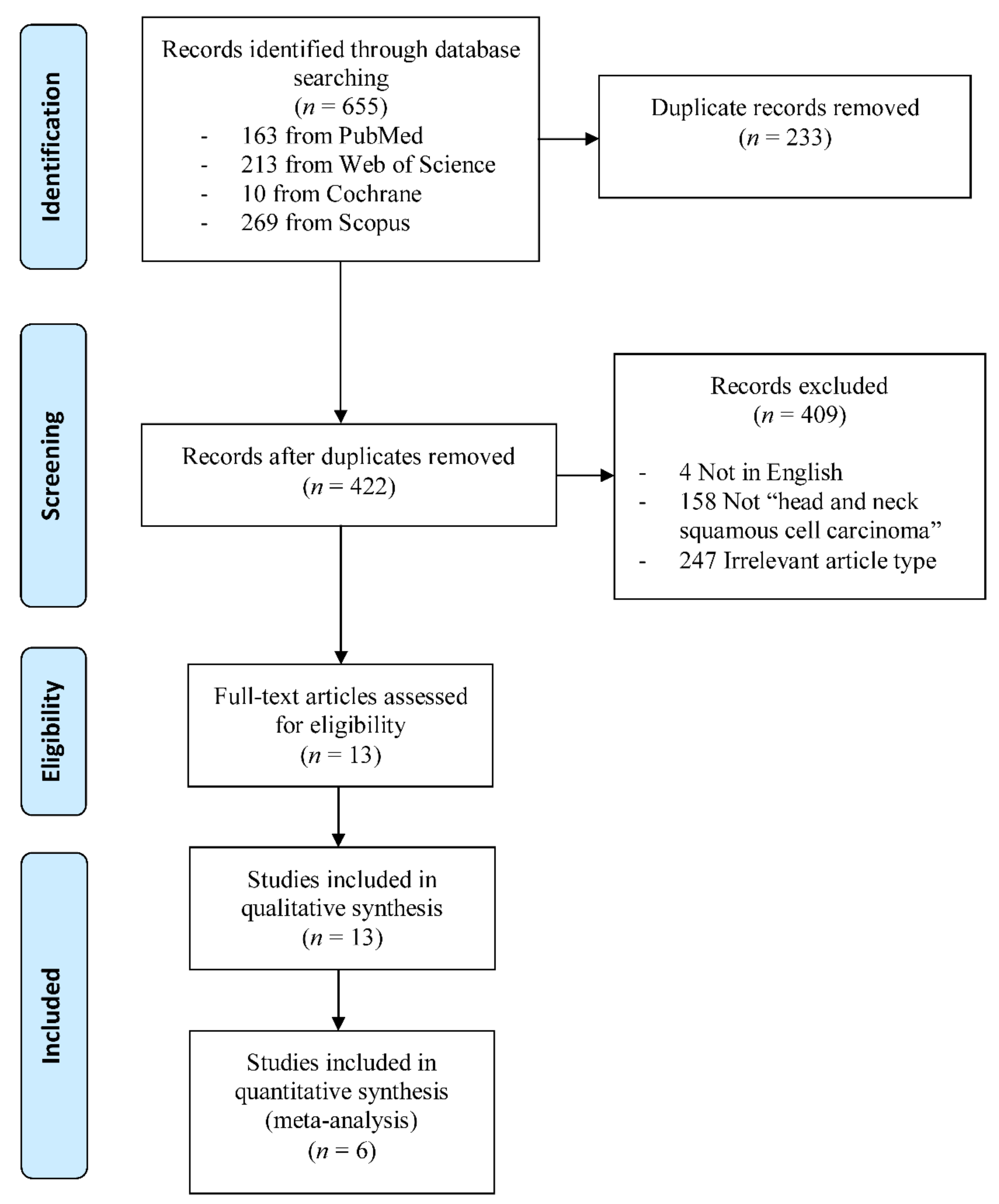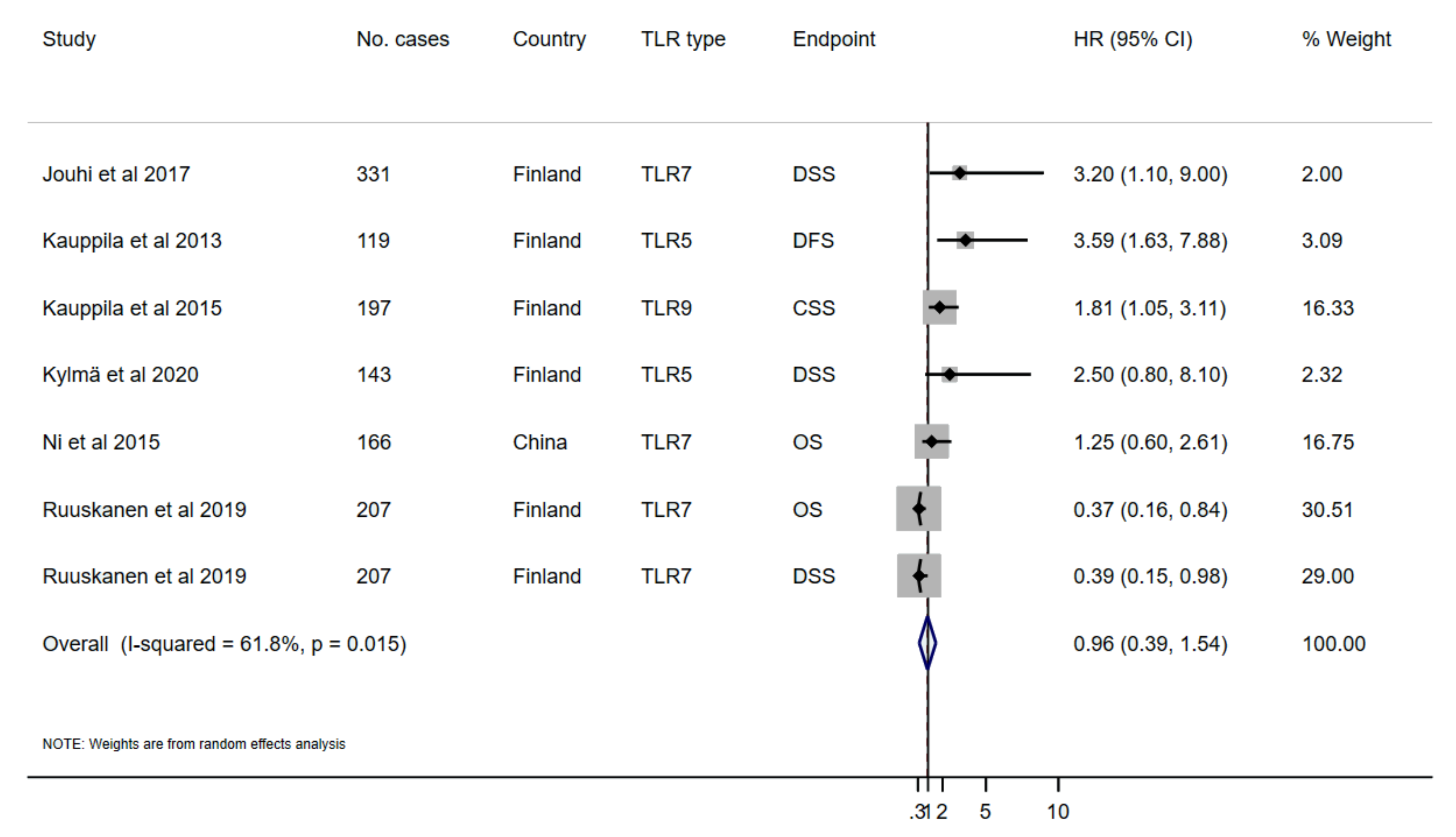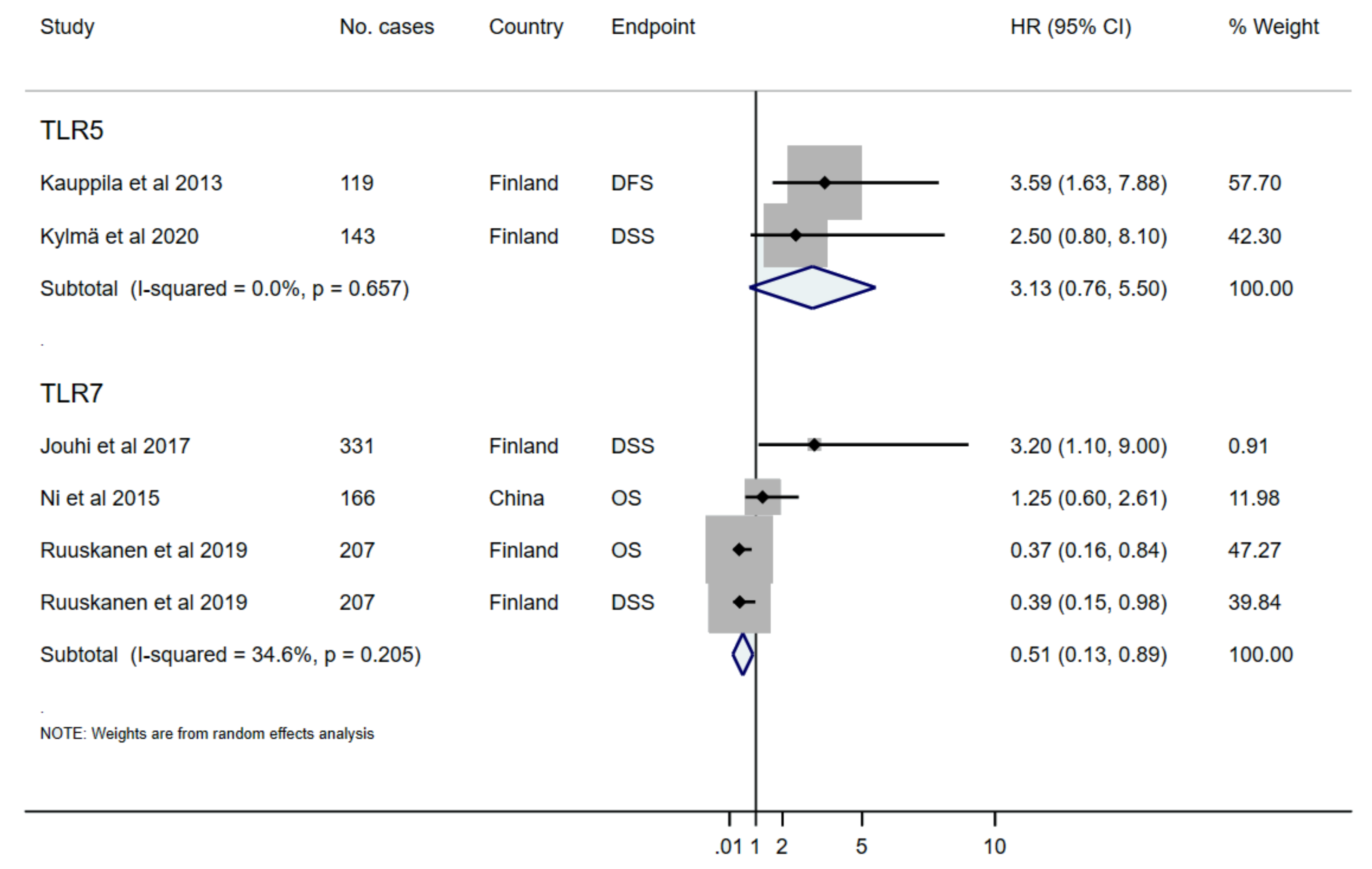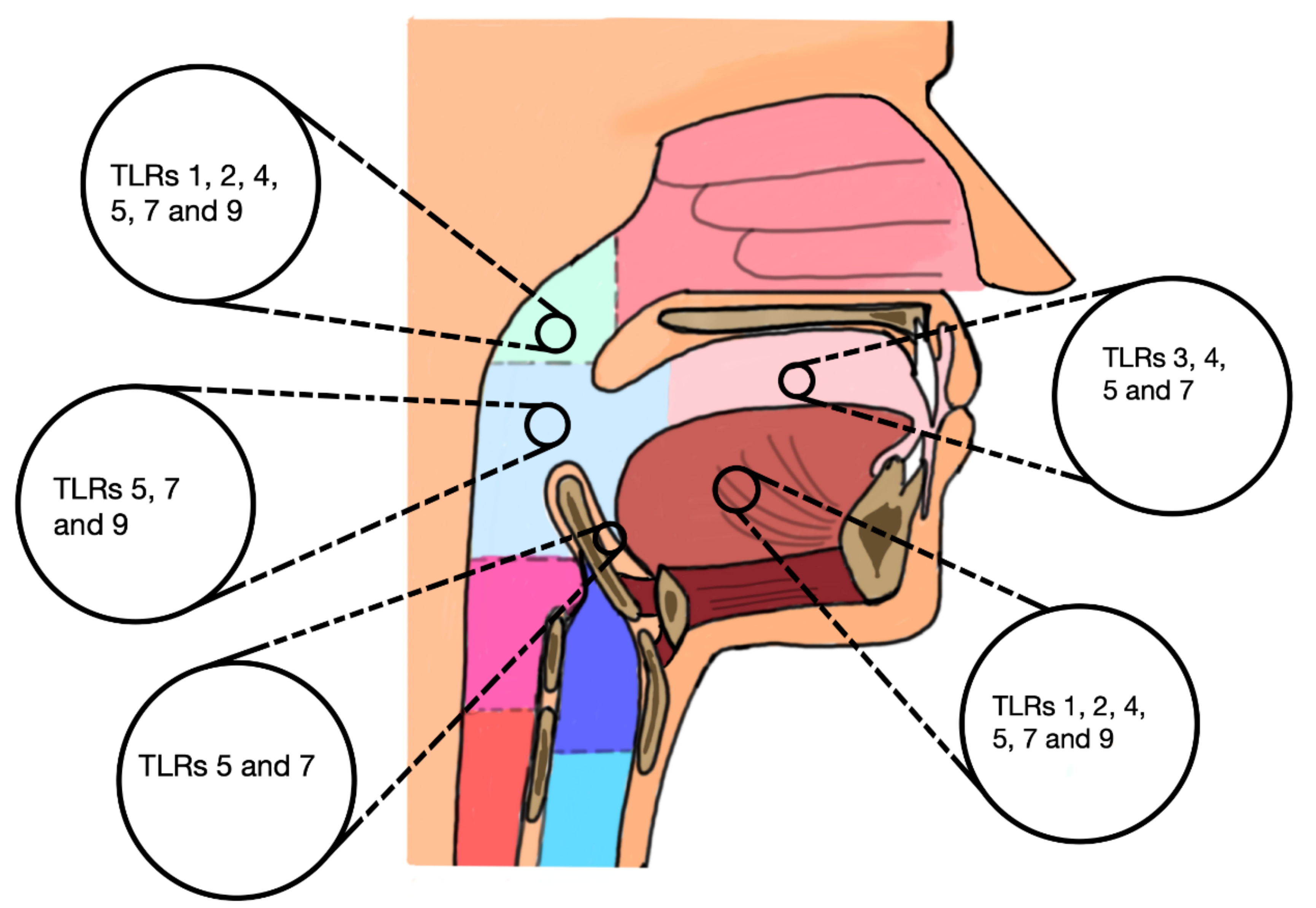The Prognostic Value of Toll-Like Receptors in Head and Neck Squamous Cell Carcinoma: A Systematic Review and Meta-Analysis
Abstract
1. Introduction
2. Results
2.1. Study Selection
2.2. Study Characteristics
2.3. Quality and Bias Assessment
2.4. The Cutoff Values
2.5. TLR and Clinicopathological Parameters of HNSCC Patients
2.6. TLR and the Viral Status of HNSCC Patients
2.7. TLR and the Survival Outcomes of HNSCC Patients
2.8. Meta-Analysis Results
3. Discussion
4. Materials and Methods
4.1. Protocol and Registration
4.2. Inclusion and Exclusion Criteria
4.3. Search Strategy and Study Screening
4.4. Data Extraction and Study Items
4.5. Assessment of Study Quality and Reporting Bias
4.6. Data Synthesis and Statistical Analysis
Supplementary Materials
Author Contributions
Funding
Acknowledgments
Conflicts of Interest
Abbreviations
| TLR | Toll-like receptor |
| HNSCC | Head and neck squamous cell carcinoma |
| OPSCC | Oropharyngeal squamous cell carcinoma |
| OSCC | Oral squamous cell carcinoma |
| NPC | Nasopharyngeal carcinoma |
| BOTSCC | Base-of-tongue squamous cell carcinoma |
| OTSCC | Oral tongue squamous cell carcinoma |
References
- Pai, S.I.; Westra, W.H. Molecular pathology of head and neck cancer: Implications for diagnosis, prognosis, and treatment. Annu. Rev. Pathol. 2009, 4, 49–70. [Google Scholar] [CrossRef]
- Fitzmaurice, C.; Abate, D.; Abbasi, N.; Abbastabar, H.; Abd-Allah, F.; Abdel-Rahman, O.; Abdelalim, A.; Abdoli, A.; Abdollahpour, I.; Abdulle, A.S.M.; et al. Global, regional, and national cancer incidence, mortality, years of life lost, years lived with disability, and disability-adjusted life-years for 29 cancer groups, 1990 to 2017: A systematic analysis for the global burden of disease study. JAMA Oncol. 2019, 5, 1749–1768. [Google Scholar]
- Vigneswaran, N.; Williams, M.D. Epidemiologic trends in head and neck cancer and aids in diagnosis. Oral Maxillofac. Surg. Clin. 2014, 26, 123–141. [Google Scholar] [CrossRef]
- Economopoulou, P.; de Bree, R.; Kotsantis, I.; Psyrri, A. Diagnostic tumor markers in head and neck squamous cell carcinoma (HNSCC) in the clinical setting. Front. Oncol. 2019, 9, 827. [Google Scholar] [CrossRef]
- Takeda, K.; Kaisho, T.; Akira, S. Toll-like receptors. Annu. Rev. Immunol. 2003, 21, 335–376. [Google Scholar] [CrossRef]
- El-Zayat, S.; Sibaii, H.; Mannaa, F.A. Toll-like receptors activation, signaling, and targeting: An overview. Bull. Natl. Res. Cent. 2019, 43, 187. [Google Scholar] [CrossRef]
- Basith, S.; Manavalan, B.; Yoo, T.H.; Kim, S.G.; Choi, S. Roles of toll-like receptors in cancer: A double-edged sword for defense and offense. Arch. Pharm. Res. 2012, 35, 1297–1316. [Google Scholar] [CrossRef]
- Huang, B.; Zhao, J.; Unkeless, J.C.; Feng, Z.H.; Xiong, H. TLR signaling by tumor and immune cells: A double-edged sword. Oncogene 2008, 27, 218–224. [Google Scholar] [CrossRef]
- Riley, R.D.; Abrams, K.R.; Sutton, A.J.; Lambert, P.C.; Jones, D.R.; Heney, D.; Burchill, S.A. Reporting of prognostic markers: Current problems and development of guidelines for evidence-based practice in the future. Br. J. Cancer 2003, 88, 1191–1198. [Google Scholar] [CrossRef]
- Kylmä, A.K.; Tolvanen, T.A.; Carpén, T.; Haglund, C.; Mäkitie, A.; Mattila, P.S.; Grenman, R.; Jouhi, L.; Sorsa, T.; Lehtonen, S.; et al. Elevated TLR5 expression in vivo and loss of NF-κΒ activation via TLR5 in vitro detected in HPV-negative oropharyngeal squamous cell carcinoma. Exp. Mol. Pathol. 2020, 114, 104435. [Google Scholar] [CrossRef]
- Jouhi, L.; Mohamed, H.; Mäkitie, A.; Remes, S.M.; Haglund, C.; Atula, T.; Hagström, J. Toll-like receptor 5 and 7 expression may impact prognosis of HPV-positive oropharyngeal squamous cell carcinoma patients. Cancer Immunol. Immunother. 2017, 66, 1619–1629. [Google Scholar] [CrossRef]
- Han, S.; Yin, X.; Wang, Y.; Xu, W.; Cheng, W. Co-expression of HIF-1 and TLR3 is associated with poor prognosis in oral squamous cell carcinoma. Int. J. Clin. Exp. Pathol. 2020, 13, 65–72. [Google Scholar]
- Yang, J.; Liu, D.; Khatri, K.S.; Wang, J.; Zhang, G.; Meng, C.; Guan, J. Prognostic value of toll-like receptor 4 and nuclear factor-κBp65 in oral squamous cell carcinoma patients. Oral Surg. Oral Med. Oral Pathol. Oral Radiol. 2016, 122, 753–764. [Google Scholar] [CrossRef]
- Ni, Y.H.; Ding, L.; Zhang, D.Y.; Hou, Y.Y.; Huang, X.; Hu, Q. Distinct expression patterns of Toll-like receptor 7 in tumour cells and fibroblast-like cells in oral squamous cell carcinoma. Histopathology 2015, 67, 730–739. [Google Scholar] [CrossRef]
- Ren, W.H.; Zhang, L.M.; Liu, H.Q.; Gao, L.; Chen, C.; Qiang, C.; Wang, X.L.; Liu, C.Y.; Li, S.M.; Huang, C.; et al. Protein overexpression of CIRP and TLR4 in oral squamous cell carcinoma: An immunohistochemical and clinical correlation analysis. Med. Oncol. 2014, 31, 120. [Google Scholar] [CrossRef]
- Grimm, M.; Munz, A.; Exarchou, A.; Polligkeit, J.; Reinert, S. Immunohistochemical detection of helicobacter pylori without association of TLR5 expression in oral squamous cell carcinoma. J. Oral Pathol. Med. 2014, 43, 35–44. [Google Scholar] [CrossRef]
- Ruuskanen, M.; Leivo, I.; Minn, H.; Vahlberg, T.; Haglund, C.; Hagström, J.; Irjala, H. Expression of toll-like receptors in non-endemic nasopharyngeal carcinoma. BMC Cancer 2019, 19, 624. [Google Scholar] [CrossRef]
- Haeggblom, L.; Näsman, A.; Ramqvist, T.; Haglund, C.; Hagström, J.; Mäkitie, A.; Dalianis, T. TLR5 and TLR7 are differentially expressed in human papillomavirus-positive and negative base of tongue squamous cell carcinoma, and TLR7 may have an independent prognostic influence. Acta Otolaryngol. 2019, 139, 206–210. [Google Scholar] [CrossRef]
- Kauppila, J.H.; Korvala, J.; Siirilä, K.; Manni, M.; Mäkinen, L.K.; Hagström, J.; Atula, T.; Haglund, C.; Selander, K.S.; Saarnio, J.; et al. Toll-like receptor 9 mediates invasion and predicts prognosis in squamous cell carcinoma of the mobile tongue. J. Oral Pathol. Med. 2015, 44, 571–577. [Google Scholar] [CrossRef]
- Mäkinen, L.K.; Atula, T.; Häyry, V.; Jouhi, L.; Datta, N.; Lehtonen, S.; Ahmed, A.; Mäkitie, A.A.; Haglund, C.; Hagström, J. Predictive role of Toll-like receptors 2, 4, and 9 in oral tongue squamous cell carcinoma. Oral Oncol. 2015, 51, 96–102. [Google Scholar] [CrossRef]
- Kauppila, J.H.; Mattila, A.E.; Karttunen, T.J.; Salo, T. Toll-like receptor 5 (TLR5) expression is a novel predictive marker for recurrence and survival in squamous cell carcinoma of the tongue. Br. J. Cancer 2013, 108, 638–643. [Google Scholar] [CrossRef]
- Long, X.; He, L.; Li, S.; Tong, L.; Wang, L.; Wang, F.; Wu, X. Expression of TLR1 in tongue squamous cell carcinoma and adjacent tissue. Int. J. Clin. Exp. Pathol. 2016, 9, 8997–9007. [Google Scholar]
- Rakoff-Nahoum, S.; Medzhitov, R. Toll-like receptors and cancer. Nat. Rev. Cancer 2009, 9, 57–63. [Google Scholar] [CrossRef]
- Bonomi, M.; Patsias, A.; Posner, M.; Sikora, A. The role of inflammation in head and neck cancer. Adv. Exp. Med. Biol. 2014, 816, 107–127. [Google Scholar]
- Song, E.J.; Kang, M.J.; Kim, Y.S.; Kim, S.M.; Lee, S.E.; Kim, C.H.; Kim, D.J.; Park, J.H. Flagellin promotes the proliferation of gastric cancer cells via the Toll-like receptor 5. Int. J. Mol. Med. 2011, 28, 115–119. [Google Scholar]
- Akira, S.; Takeda, K. Toll-like receptor signalling. Nat. Rev. Immunol. 2004, 4, 499–511. [Google Scholar] [CrossRef]
- Chi, H.; Li, C.; Zhao, F.S.; Zhang, L.; Ng, T.B.; Jin, G.; Sha, O. Anti-tumor activity of toll-like receptor 7 agonists. Front. Pharmacol. 2017, 8, 304. [Google Scholar] [CrossRef]
- Fares, J.; Fares, M.Y.; Khachfe, H.H.; Salhab, H.A.; Fares, Y. Molecular principles of metastasis: A hallmark of cancer revisited. Signal Transduct. Target Ther. 2020, 5, 1–17. [Google Scholar] [CrossRef]
- Salem, A.; Almahmoudi, R.; Vehviläinen, M.; Salo, T. Role of the high mobility group box 1 signalling axes via the receptor for advanced glycation end-products and toll-like receptor-4 in the immunopathology of oral lichen planus: A potential drug target? Eur. J. Oral Sci. 2018, 126, 244–248. [Google Scholar] [CrossRef]
- Salem, A.; Mustafa, R.; Listyarifah, D.; Al-Samadi, A.; Barreto, G.; Nordström, D.; Eklund, K.K. Altered expression of toll-like receptors in human oral epithelium in oral lichenoid reactions. Am. J. Dermatopathol. 2017, 39, 811–818. [Google Scholar] [CrossRef]
- Bray, F.; Ferlay, J.; Soerjomataram, I.; Siegel, R.L.; Torre, L.A.; Jemal, A. Global cancer statistics 2018: GLOBOCAN estimates of incidence and mortality worldwide for 36 cancers in 185 countries. CA. Cancer J. Clin. 2018, 68, 394–424. [Google Scholar] [CrossRef] [PubMed]
- Lim, H.; Kim, D.H.; Jung, H.Y.; Gong, E.J.; Na, H.K.; Ahn, J.Y.; Kim, M.Y.; Lee, J.H.; Choi, K.S.; Choi, K.D.; et al. Clinical significance of early detection of esophageal cancer in patients with head and neck cancer. Gut Liver 2015, 9, 159–165. [Google Scholar] [CrossRef] [PubMed]
- Sheyhidin, I.; Nabi, G.; Hasim, A.; Zhang, R.P.; Ainiwaer, J.; Ma, H.; Wang, H. Overexpression of TLR3, TLR4, TLR7 and TLR9 in esophageal squamous cell carcinoma. World J. Gastroenterol. 2011, 17, 3745–3751. [Google Scholar] [CrossRef]
- Takala, H.; Kauppila, J.H.; Soini, Y.; Selander, K.S.; Vuopala, K.S.; Lehenkari, P.P.; Saarnio, J.; Karttunen, T.J. Toll-like receptor 9 is a novel biomarker for esophageal squamous cell dysplasia and squamous cell carcinoma progression. J. Innate Immun. 2011, 3, 631–638. [Google Scholar] [CrossRef]
- Zhang, J.J.; Wu, H.S.; Wang, L.; Tian, Y.; Zhang, J.H.; Wu, H.L. Expression and significance of TLR4 and HIF-1alpha in pancreatic ductal adenocarcinoma. World J. Gastroenterol. 2010, 16, 2881–2888. [Google Scholar] [CrossRef]
- Sato, Y.; Motoyama, S.; Wakita, A.; Kawakita, Y.; Liu, J.; Nagaki, Y.; Nanjo, H.; Terata, K.; Imai, K.; Saito, H.; et al. TLR3 expression status predicts prognosis in patients with advanced thoracic esophageal squamous cell carcinoma after esophagectomy. Am. J. Surg. 2018, 216, 319–325. [Google Scholar] [CrossRef] [PubMed]
- Li, X.; Li, H.; Dong, X.; Wang, X.; Zhu, J.; Cheng, Y.; Fan, P. Expression of NF-κB and TLR-4 is associated with the occurrence, progression and prognosis of esophageal squamous cell carcinoma. Int. J. Clin. Exp. Pathol. 2018, 11, 5850–5859. [Google Scholar]
- Ahn, M.Y.; Kwon, S.M.; Cheong, H.H.; Park, J.H.; Lee, J.; Min, S.K.; Ahn, S.G.; Yoon, J.H. Toll-like receptor 7 agonist, imiquimod, inhibits oral squamous carcinoma cells through apoptosis and necrosis. J. Oral Pathol. Med. 2012, 41, 540–546. [Google Scholar] [CrossRef]
- Dewan, M.Z.; Vanpouille-Box, C.; Kawashima, N.; DiNapoli, S.; Babb, J.S.; Formenti, S.C.; Adams, S.; Demaria, S. Synergy of topical toll-like receptor 7 agonist with radiation and low-dose cyclophosphamide in a mouse model of cutaneous breast cancer. Clin. Cancer Res. 2012, 18, 6668–6678. [Google Scholar] [CrossRef]
- Cheadle, E.J.; Lipowska-Bhalla, G.; Dovedi, S.J.; Fagnano, E.; Klein, C.; Honeychurch, J.; Illidge, T.M. A TLR7 agonist enhances the antitumor efficacy of obinutuzumab in murine lymphoma models via NK cells and CD4 T cells. Leukemia 2017, 31, 2278. [Google Scholar] [CrossRef]
- Moher, D.; Liberati, A.; Tetzlaff, J.; Altman, D.G.; PRISMA Group. Preferred reporting items for systematic reviews and meta-analyses: The PRISMA statement. PLoS Med. 2009, 6, e1000097. [Google Scholar] [CrossRef] [PubMed]
- Booth, A.; Clarke, M.; Dooley, G.; Ghersi, D.; Moher, D.; Petticrew, M.; Stewart, L. The nuts and bolts of PROSPERO: An international prospective register of systematic reviews. Syst. Rev. 2012, 1, 2. [Google Scholar] [CrossRef] [PubMed]
- McShane, L.M.; Altman, D.G.; Sauerbrei, W.; Taube, S.E.; Gion, M.; Clark, G.M. Statistics subcommittee of the nci-eortc working group on cancer diagnostics. Reporting recommendations for tumour MARKer prognostic studies (REMARK). Br. J. Cancer 2005, 93, 387–391. [Google Scholar] [CrossRef] [PubMed]
- Hujanen, R.; Almahmoudi, R.; Karinen, S.; Nwaru, B.I.; Salo, T.; Salem, A. Vasculogenic mimicry: A promising prognosticator in head and neck squamous cell carcinoma and esophageal cancer? A systematic review and meta-analysis. Cells 2020, 9, 507. [Google Scholar] [CrossRef]




| Study | Origin | Tumour Type | Tumour Stage | Cases | Age | Study Period | TLR | Compliance to REMARK |
|---|---|---|---|---|---|---|---|---|
| [10] | Finland | OPSCC | I–IV | 143 | HPV+ 60.8 HPV− 62.2 (M) | 2012–2016 | TLR-5 | Fulfilled all items |
| [12] | China | OSCC | T1–T4 | 90 | 62.5 (M) | 2005–2008 | TLR-3 | Lacked item No. 5 |
| [17] | Finland | NPC | I–IV | 207 | 57 (M) | 1990–2009 | TLR-1, TLR-2, TLR-4, TLR-5, TLR-7, TLR-9 | Fulfilled all items |
| [18] | Sweden | BOTSCC | I–IV | 77 | 62 (M) | 2000–2011 | TLR-5, TLR-7 | Lacked item No. 5 |
| [11] | Finland | OPSCC | I–IV | 331 | - | 2000–2009 | TLR-5, TLR-7, TLR-9 | Fulfilled all items |
| [13] | China | OSCC | I–IV | 110 | 60 (Med) | 2006–2010 | TLR-4 | Lacked item No. 5 |
| [22] | China | TSCC | I–IV | 60 | 57 (M) | 2013–2015 | TLR-1 | Lacked items No. 1, 4, 5 |
| [14] | China | OSCC | I–IV | 166 | - | 2000–2011 | TLR-7 | Lacked item No. 3 |
| [19] | Finland | OTSCC | 1–4 | 197 | 65 (Med) | 1981–2009 | TLR-9 | Fulfilled all items |
| [20] | Finland | OTSCC | I–IV | 73 | 59 (Med) | 1992–2002 | TLR-2, TLR-4, TLR-5, TLR-7, TLR-9 | Lacked item No. 5 |
| [15] | China | OSCC | T1–T4 | 61 | 59.31 (M) | 1992–2007 | TLR-4 | Lacked items No. 4,5 |
| [16] | Germany | OSCC | I–IV | 191 | - | - | TLR-5 | Lacked item No. 1 |
| [21] | Finland | OTSCC | 1–4 | 119 | 66 (Med) | 1981–2009 | TLR-5 | Fulfilled all items |
| Study | Antibody Info | Dilution | Tissue | Scoring Grade | Cutoff Value |
|---|---|---|---|---|---|
| [10] | TLR-5: (mAb, Mo), Novus | 1:100 | TMA | Neg. 0, mild 1, moderate 2, strong 3 | Values (1–3) are scored as positive |
| [12] | TLR-3: Abcam; clonality: ND | 1:100 | FFPE | Low, high | - |
| [17] | TLR-1: (Rb) Santa Cruz Bio. Inc. TLR-2: (pAb, Rb), Santa Cruz. TLR-4: (pAb, Rb) Santa Cruz. TLR-5: (mAb, Mo), Novus Biologicals. TLR-7: (pAb, Rb), Imgenex/Novus Biologicals. TLR-9: (pAb, Rb), Santa Cruz | TLR-1 1:100, TLR-2 1:200, TLR-4 1:300, TLR-5 1:100, TLR-7 1:300, TLR-9 1:100 | FFPE | Neg., mild, moderate, or strong | It is required that >80% of tumour cells in the sample stained positively |
| [18] | TLR-5: (mAb, Mo), Imgenex TLR-7: (mAb, Rb), Imgenex | TLR-5 1:200 TLR-7 1:300 | FFPE | Neg., weak, medium, strong | - |
| [11] | TLR-5: (mAb, Mo), Imgenex TLR-7: (mAb, Rb), Imgenex TLR-9: (pAb, Rb), Santa Cruz Bio. Inc. | TLR-5 1:200, TLR-7 1:300, TLR-9 1:100 | TMA | 0–3 (0 = none, 3 = strong) | Values 1–3 are scored as positive |
| [13] | TLR-4: (pAb, Rb) Boster Biological Tech Co. | 1:150 | FFPE | Low, high | IRS 3 |
| [22] | TLR-1: (pAb), Abcam | 1:100 | FFPE | Percentage of stained cells 0–4 | IRS: low 0–3, high 2–4. The (%) of stained cells was 0 for ≤ 25% staining; 1 for 25–50%; 2 for 50%; 3 for 51–75%; and 4 for more than 75% staining |
| [14] | TLR-7: Abcam; clonality: ND | - | FFPE | Grade 1–3 | Grade 1 (1–3) Grade 2 (4–6) Grade 3 (7–9) |
| [19] | TLR-9: (mAb, Mo, IgG1), Imgenex | 1:150 | FFPE | Low, high | Histoscore: low 0–64, high 65–300 |
| [20] | TLR-2: (pAb, Rb), Santa Cruz Bio. Inc. TLR-4: (pAb Rb), Santa Cruz Bio. Inc. TLR-5: (mAb), Imgenex. TLR-7: (pAb) Imgenex. TLR-9: (pAb), Santa Cruz Bio. Inc. | TLR-2 1:50, TLR-4 1:50, TLR-5 1:200, TLR-7 1:300, TLR-9 1:100 | TMA | TLR-2, 4 and 7: 0–4 (0 = none, 4 = very high), TLR-5 and 9: 0–3 (0 = neg., 3 = strongly positive) | Low: none/mild High: mod./strong |
| [15] | TLR-4: Protein Tech & Affbiotect | 1:150 | FFPE | Over-expressed, under-expressed | 50% |
| [16] | TLR-5: (mAb, Mo) (Imgenex) | 1:100 | FFPE | Low expression; high expression | 7% |
| [21] | TLR-5: (mAb, Mo, IgG2a), Imgenex | 1:150 | FFPE | Weak and strong expression | Histoscore: weak 0–135; strong 136–300 |
| Study | TLR | Endpoint | Adjusted Analysis | Adjusted Factors | Results Interpretation |
|---|---|---|---|---|---|
| [10] | TLR-5 | DSS | HR = 2.5, P = 0.129, 95% CI = 0.8–8.1 | Gender, age, smoking, TN-class, stage, treatment, HPV status | High TLR-5 expression was an independent indicator of poor DSS in those with HPV-positive OPSCC. High TLR-5 was significantly associated with LN-status, tumour site and grade. |
| [12] | TLR-3 | OS | - | - | TLR-3 expression was associated with poor prognosis and shorter OS. Higher TLR-3 was also associated with pathologic grade. |
| [17] | TLR-1 TLR-2 TLR-4 TLR-5 TLR-7 TLR-9 | OS | TLR-7: HR = 0.37, P = 0.018, 95% CI = 0.16–0.84 | Gender, age, ethnicity, smoking, TN-class, stage, histology, virus status, treatment, irradiation technique | Patients with positive TLR-7 tumour expression had better OS than those with no TLR-7 expression. |
| DSS | TLR-7: HR = 0.39, P = 0.046, 95% CI = 0.15–0.98 | ||||
| [18] | TLR-5 TLR-7 | DSS | - | - | TLR-5 or TLR-7 did not have a statistically significant correlation with clinical outcome or survival. |
| DFS | - | ||||
| [11] | TLR-5 TLR-7 TLR-9 | DSS | TLR-7: HR = 3.2, P = 0.027, 95% CI = 1.1–9.0 | Gender, smoking, TN-class, HPV status, treatment | High expression of TLR-5 and low expression of TLR-7 are correlated with poor DSS and RFS of HPV-positive patients. |
| RFS | - | ||||
| [13] | TLR-4 | OS | RR=2.334, P=0.006, 95% CI=1.277-4.267 | TN-stage, adjuvant therapy, differentiation, invasion depth, cytoplasmic and nuclear NF-kBp65 | High TLR-4 expression was an independent prognostic factor and significantly associated with lower DFS, DSS and OS. High TLR-4 expression was correlated with pTNM-stage, differentiation and invasion. |
| DSS | RR=2.495, P=0.005, 95% CI=1.321-4.712 | ||||
| DFS | RR=2.888, P=0.001, 95% CI=1.532-5.443 | ||||
| [22] | TLR-1 | - | - | - | TLR-1 plays an inhibitory role in the development and progression of TSCC. High TLR-1 was correlated with TNM-staging. |
| [14] | TLR-7 | OS | HR = 1.253, P = 0.547 (NS), 95% CI = 0.601–2.613 | Gender, age, smoking, TNM-stage, differentiation, LNM, inflammation | High expression of TLR-7 in tumour cells correlated with shorter OS but not with DFS. On the contrary, high TLR-7 in stromal fibroblast-like cells was correlated with better survival time. High TLR-7 was also significantly associated with tumour differentiation. |
| DFS | - | ||||
| [19] | TLR-9 | CSS | HR = 1.810, P = 0.024, 95% CI = 1.053–3.112 | Age, tumour stage, histologic grade | High TLR-9 expression was an independent predictor of poor CSS. TLR-9 correlates significantly with tumour grade. |
| [20] | TLR-2 TLR-4 TLR-5 TLR-7 TLR-6 | OS | - | Pathologic T-stage, grade, presence of occult neck metastases, and invasion | Negative or mild TLR-5 expression was related to worse DSS. |
| DSS | - | ||||
| DFS | - | ||||
| [15] | TLR-4 | POS | - | - | Patients with TLR-4 amplification had a shorter POS and high TLR-4 expression also correlates with T-stage, histological classification and metastasis. |
| [16] | TLR-5 | DFS | - | - | TLR-5 expression was not associated with any clinicopathological characteristics or impact on survival. |
| [21] | TLR-5 | DFS | HR = 3.587, 95% CI = 1.632–7.882 | Gender, age, stage, histologic grade, adjuvant therapy | Strong TLR-5 expression was independent prognostic factor associated with reduced DFS and CSS. |
| CSS | - |
| Study | Number of Cases | Country | TLR Type | Endpoint | Hazard Ratio (95% CI) | Relative Weight, % |
|---|---|---|---|---|---|---|
| All Studies | ||||||
| [21] | 119 | Finland | TLR-5 | DFS | 3.59 (1.63–7.88) | 2.00 |
| [10] | 143 | Finland | TLR-5 | DSS | 2.50 (0.80–8.10) | 3.09 |
| [11] | 331 | Finland | TLR-7 | DSS | 3.20 (1.10–9.00) | 16.33 |
| [14] | 166 | China | TLR-7 | OS | 1.25 (0.60–2.61) | 2.32 |
| [17] | 207 | Finland | TLR-7 | DSS | 0.39 (0.15–0.98) | 16.75 |
| [17] | 207 | Finland | TLR-7 | OS | 0.37 (0.16–0.84) | 30.51 |
| [19] | 197 | Finland | TLR-9 | CSS | 1.81 (1.05–3.11) | 29.00 |
| Pooled overall estimate | 0.96 (0.39–1.54) | 100.00 | ||||
| Heterogeneity measures | I-squared = 61.8% (p-value = 0.0015), Tau-squared = 0.2533 | |||||
| Subgroup Analysis (TLR subtype) | ||||||
| Study | Number of Cases | Country | TLR Type | Endpoint | Hazard Ratio (95% CI) | Relative Weight, % |
| TLR-5 Studies | ||||||
| [21] | 119 | Finland | TLR-5 | DFS | 3.59 (1.63–7.88) | 57.70 |
| [10] | 143 | Finland | TLR-5 | DSS | 2.50 (0.80–8.10) | 42.30 |
| Pooled overall estimate | 3.13 (0.76–5.50) | 100.00 | ||||
| Heterogeneity measures | I-squared = 0.0% (p-value = 0.657), Tau-squared = 0.000 | |||||
| TLR-7 Studies | ||||||
| [11] | 331 | Finland | TLR-7 | DSS | 3.20 (1.10–9.00) | 0.91 |
| [14] | 166 | China | TLR-7 | OS | 1.25 (0.60–2.61) | 11.98 |
| [17] | 207 | Finland | TLR-7 | OS | 0.37 (0.16–0.84) | 47.27 |
| [17] | 207 | Finland | TLR-7 | DSS | 0.39 (0.15–0.98) | 39.84 |
| Pooled overall estimate | 0.51 (0.13–0.89) | 100.00 | ||||
| Heterogeneity measures | I-squared = 34.6% (p-value = 0.205), Tau-squared = 0.0489 | |||||
| Inclusion Criteria | Exclusion Criteria |
|---|---|
| Original research articles | The retrieved records were case reports; reviews; letters; etc. |
| Histological tissue samples from human patients | Animal model studies and tests |
| Patients diagnosed with HNSCC | Articles not written in English language |
| Studies reported the association between TLR immunoexpression and the survival outcomes | Insufficient information of the correlation between clinical features and/or survival outcomes |
© 2020 by the authors. Licensee MDPI, Basel, Switzerland. This article is an open access article distributed under the terms and conditions of the Creative Commons Attribution (CC BY) license (http://creativecommons.org/licenses/by/4.0/).
Share and Cite
Hasnat, S.; Hujanen, R.; Nwaru, B.I.; Salo, T.; Salem, A. The Prognostic Value of Toll-Like Receptors in Head and Neck Squamous Cell Carcinoma: A Systematic Review and Meta-Analysis. Int. J. Mol. Sci. 2020, 21, 7255. https://doi.org/10.3390/ijms21197255
Hasnat S, Hujanen R, Nwaru BI, Salo T, Salem A. The Prognostic Value of Toll-Like Receptors in Head and Neck Squamous Cell Carcinoma: A Systematic Review and Meta-Analysis. International Journal of Molecular Sciences. 2020; 21(19):7255. https://doi.org/10.3390/ijms21197255
Chicago/Turabian StyleHasnat, Shrabon, Roosa Hujanen, Bright I. Nwaru, Tuula Salo, and Abdelhakim Salem. 2020. "The Prognostic Value of Toll-Like Receptors in Head and Neck Squamous Cell Carcinoma: A Systematic Review and Meta-Analysis" International Journal of Molecular Sciences 21, no. 19: 7255. https://doi.org/10.3390/ijms21197255
APA StyleHasnat, S., Hujanen, R., Nwaru, B. I., Salo, T., & Salem, A. (2020). The Prognostic Value of Toll-Like Receptors in Head and Neck Squamous Cell Carcinoma: A Systematic Review and Meta-Analysis. International Journal of Molecular Sciences, 21(19), 7255. https://doi.org/10.3390/ijms21197255






